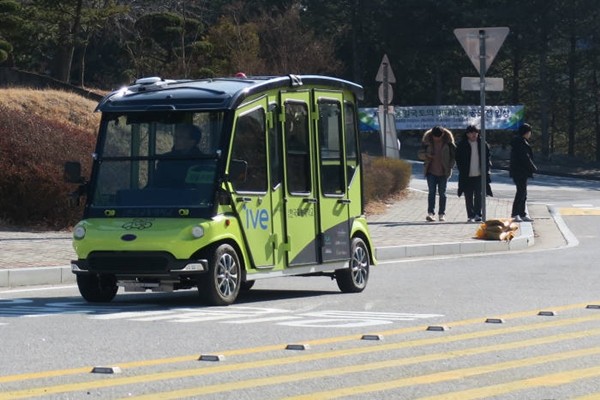Self-driving car that is completed with total investment cost of $64,400 (70 million KRW) on the car, telecommunication network, and control infrastructures will be used as a shuttle for a South Korean university. It has been completed through techniques from universities, private companies, and research institutes while minimizing expensive parts such as LIDAR (Light Detection and Ranging). Although this car will be used within limited space, it proves realistic possibility of commercialization of self-driving car without having to spend so much money.
Korea National University of Transportation launched its campus self-driving shuttle called ‘ive’ at its Chungju Campus on the 13th. This self-driving shuttle will operate every day for four to six hours within 2km of area. Its driving speed will be under 20km and it is based on a small electric bus. With V2X (Vehicle to Everything) telecommunication technologies and control center at the center, this self-driving shuttle will operate while communicating with various elements such as road infrastructures, surrounding cars, and pedestrians that it faces.
“Without having to invest enormous amount of our budget, we are able to operate realistic self-driving through students, professors, private companies, and government organizations.” said Chancellor Kim Young-ho of Korea National University of Transportation. “We are going to slowly increase level of completion of self-driving technology along with private companies by utilizing Big Data that is drawn from ‘ive’ service.”

This self-driving shuttle is based on six-person electric bus developed by Daechang Motors that specializes ultra-small electric vehicles. It is equipped with South Korean battery (9kWh) and it can drive up to about 80km with just single charge. It costs about $27,600 (30 million KRW) to make this electric bus including LIDAR (LIDAR and 8CH) that costs about $8,280 (9 million KRW), GPS, and cameras and telecommunication devices. Telecommunication network that is needed to implement V2X is operated through Wi-Fi wireless ‘Backhaul’ that is developed by Korea National University of Transportation and its own control center.
Control center communicates and controls ‘ive’ in real-time by automatically analyzing regular cars, pedestrians, and blind spots through IP cameras (HD) that are installed at seven different locations within the campus. Also this shuttle is applied with accurate measurement technology that is based on 3D map, which is co-developed by Korea Land and Geospatial Informatix Corporation and Korea National University of Transportation. It has higher level of completion of driving as it utilizes magnetic induction sensors that are buried under roads.
“ive is the first South Korean model that is made through collaborated self-driving technologies (telecommunication, sensor, map, and control center).” said Director Moon Cheol of Korea National University of Transportation’s ICT Convergence Center. “We are going to slowly increase level of completion of self-driving technologies through ‘ive’ service and develop a model that can be used in different universities or tourist spots.”
Korea National University of Transportation is planning to increase number of unmanned self-driving shuttle from one to three by the first half of 2018.
Staff Reporter Park, Taejoon | gaius@etnews.com